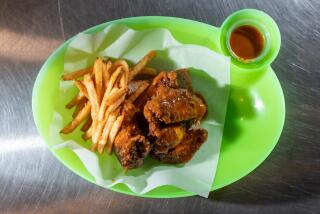2 Fruit-Flavored Custard Sauces
A number of letters have accumulated in the mailbox recently, several from cooks who have questions and others from those who have lost recipes from this column or who want to obtain copies of my cookbook but cannot find it in bookstores.
If you have lost or misplaced a recipe or need other information, please send a stamped, self-addressed envelope to me in care of The Food Processor, Box 286, Gracie Station, New York, N.Y. 10028.
Among the most frequent problems encountered are extremely wet or sluggish bread doughs. Most of the yeast doughs that appear in this column are designed to be wetter than others. However, those that are sluggish when rising, or that don’t rise sufficiently, probably need a small increase in the amount of flour called for in the recipe.
Varies From Bag to Bag
Since flour varies from bag to bag, brand to brand and season to season throughout the United States and Canada, the amounts in almost any recipe may vary from one-quarter to one-half cup.
When a bread dough seems much too wet, sprinkle two tablespoons flour over the dough in the processor container and process for five seconds, or until the flour is incorporated. Repeat this as necessary until the dough has progressed from very wet to slightly tacky or just moist.
Pasta dough is somewhat trickier since it can toughen if overprocessed. Proceed by adding flour in two tablespoon batches, but be sure to pulse in the flour in short half-second bursts.
The two following recipes for flavored custard sauces should not present any processing problems. Both are made in quantities suitable for standard-size processors, and larger machines handle them easily. Neither requires on-the-stove cooking.
Instant Processor Method
Basic custard sauce, or creme anglaise, is nothing more than a combination of eggs, sugar and half and half, cooked until the eggs thicken the mixture to a consistency that will coat the back of a spoon.
For this instant processor method, thickening begins when the egg yolks reach a temperature of about 170 degrees or just as soon as the simmering half and half (in which sugar has been dissolved) is poured into the egg yolks. It is important to not let the simmering mixture cool; otherwise, yolks do not become hot enough to thicken properly.
Basic custard sauce can be flavored in ways that are interesting and suitable for serving with plain cake or with summer fruits such as strawberries, raspberries or blueberries.
No Longer Relying on Imports
Following is a custard sauce flavored with orange peel after processing and a custard sauce recipe that processes passion fruit pulp into the egg yolks.
Passion fruit, which look likes oversized wrinkly black Ping-Pong balls, are once again being cultivated in California. This means that we are no longer reliant only on passion fruit imported from New Zealand.
Anyone who has not tasted passion fruit should not be put off by the ugly appearance of the fruit--inside or out. The flavor is truly exceptional. ORANGE CUSTARD SAUCE
1/3 cup sugar
1 1/2 cups half and half
7 egg yolks
1 medium orange
1 teaspoon vanilla
Combine sugar and half and half in medium saucepan and stir well. Heat to simmering.
Place egg yolks in processor fitted with metal blade. With motor running, drizzle simmering liquid into machine 1 minute. Transfer contents of container to mixing bowl. Strip off orange peel with vegetable peeler, adding peel to mixing bowl. (Reserve orange for other use.)
Set custard aside until cool. Stir in vanilla. Cool to room temperature and strain. Cover and refrigerate until serving time. Makes 4 to 6 servings. PASSION CUSTARD SAUCE
4 medium passion fruit, halved
6 egg yolks
1 1/2 cups half and half
1/3 cup sugar
1 teaspoon vanilla
Scrape interiors of passion fruit (including seeds) into processor container fitted with metal blade. Add egg yolks.
Combine half and half and sugar in medium saucepan and stir well. Heat to simmering. With motor running, drizzle hot simmering liquid into machine 1 minute. Strain mixture into mixing bowl. Cool, add vanilla, cover and refrigerate until serving time. Makes 4 to 6 servings.
More to Read
Eat your way across L.A.
Get our weekly Tasting Notes newsletter for reviews, news and more.
You may occasionally receive promotional content from the Los Angeles Times.










